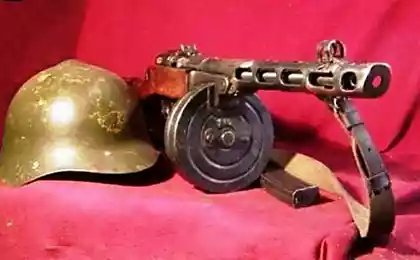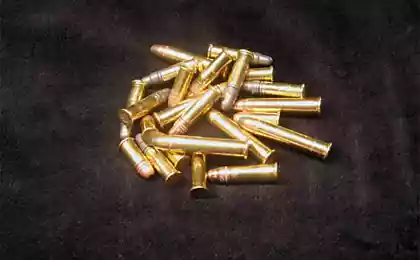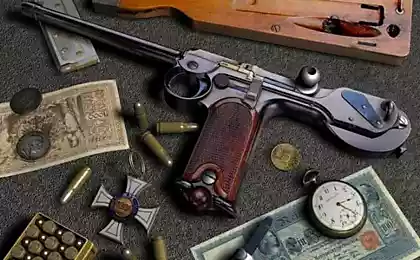1934
8 most unusual ancient weapons
Chu Kō
Chinese weapons, it can be called the progenitor of the automatic rifle. In the wooden section on the crossbow there were 10 arrows, which were reloaded when the triangular lever was pulled back after the shot. It was last seen in the Sino-Japanese Wars of 1894-1895, after the advent of firearms. On average, the crossbow produced 10 arrows in 15 seconds. Compared to the speed of recharging conventional bows and crossbows, this was a great achievement. For more damage, the arrows were lubricated with poison from the aconite flower.

Dubinka

It was used by Maori tribes in New Zealand. This simple-looking thing was made of jade. To the Maori, it was a sacred weapon. They gave names to their clubs and passed them on from generation to generation. The Maori even believed that they contained their own mana (spiritual power). The club was a symbol of leadership.
Curved swords
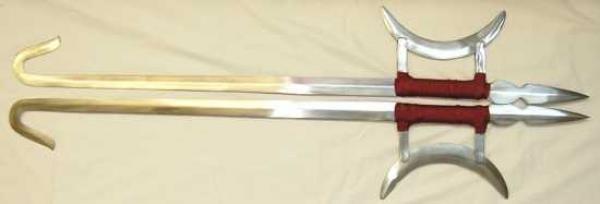
Such curved swords were worn in China by Shaolin monks. These beautiful blades were forged in the shape of a hook so that their owner could connect them and wear them as one solid blade. Made in the shape of a crescent, the guard perfectly blocked blows and literally dissected enemies. Ephesus was sharpened to attack the enemy at close range. The length of this sword was 121-188 cm. These swords were used mostly by civilians, not the army.
kpinga

Kpinga is a throwing knife used by experienced warriors of the Azanda tribe. They lived in Nubia, a region of Africa that includes northern Sudan and southern Egypt. This knife was up to 55.88 cm long and had 3 blades with a base in the center. The blade closest to the handle had the shape of a male genitalia and represented the male power of its owner. The very design of the pinga blades increased the chances of hurting the enemy as much as possible upon contact. When the owner of the knife married, he presented kpinga as a gift to the family of his future wife.
Skisseur

This strange weapon was used in gladiatorial battles in the Roman Empire. The metal cavity on the basis of the scyssor covered the hand of the gladiator, which made it easy to block blows, as well as apply their own. The syssor was made of solid steel and was 45 cm long. It was surprisingly light, which allowed for quick strikes.
chakram

You can't play frisbee with that. It was usually thrown vertically rather than horizontally. This deadly metal circle was up to 30 cm in diameter. Its very sharp edges could easily cut off an arm or leg. This weapon originated in India, where it was used by powerful Sikhs. One way to throw chakrama was to unwind the ring on the index finger, and then a sharp movement of the wrist to throw weapons at the enemy.
Qatar
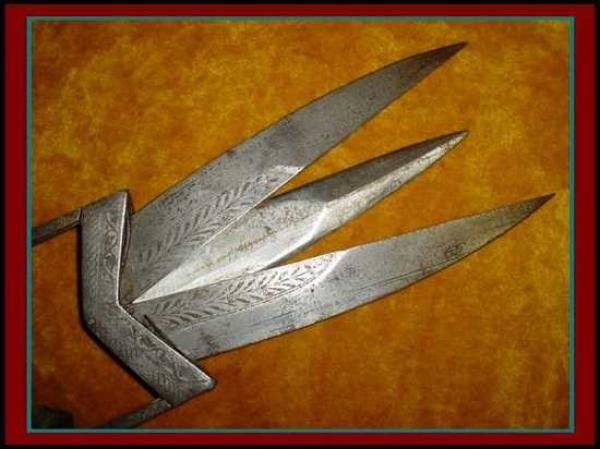
This Indian weapon gave its wolverine claw owner, the blade lacked only the strength and cutting ability of the adamant. At first glance, a cataract is one blade, but when the lever on the handle is pressed, this blade is divided into three – one in the middle and two on the sides. Three blades not only give the weapon efficiency, but also intimidate the enemy. The shape of the handle makes it easy to block impacts. The triple blade can cut any Asian armor.
zhua

Another Chinese weapon. The iron “hand” of Zhua had claws at the ends, which easily tore pieces of flesh from the body. The sheer weight of the Zhua was enough to kill the enemy, but with the claws, things looked even more eerie. If Zhua used an experienced warrior, he could pull soldiers off their horses. But the main purpose of Zhua was to snatch shields from the hands of opponents, leaving them defenseless against deadly claws.
Source: fact-planet.ru
Chinese weapons, it can be called the progenitor of the automatic rifle. In the wooden section on the crossbow there were 10 arrows, which were reloaded when the triangular lever was pulled back after the shot. It was last seen in the Sino-Japanese Wars of 1894-1895, after the advent of firearms. On average, the crossbow produced 10 arrows in 15 seconds. Compared to the speed of recharging conventional bows and crossbows, this was a great achievement. For more damage, the arrows were lubricated with poison from the aconite flower.

Dubinka

It was used by Maori tribes in New Zealand. This simple-looking thing was made of jade. To the Maori, it was a sacred weapon. They gave names to their clubs and passed them on from generation to generation. The Maori even believed that they contained their own mana (spiritual power). The club was a symbol of leadership.
Curved swords

Such curved swords were worn in China by Shaolin monks. These beautiful blades were forged in the shape of a hook so that their owner could connect them and wear them as one solid blade. Made in the shape of a crescent, the guard perfectly blocked blows and literally dissected enemies. Ephesus was sharpened to attack the enemy at close range. The length of this sword was 121-188 cm. These swords were used mostly by civilians, not the army.
kpinga

Kpinga is a throwing knife used by experienced warriors of the Azanda tribe. They lived in Nubia, a region of Africa that includes northern Sudan and southern Egypt. This knife was up to 55.88 cm long and had 3 blades with a base in the center. The blade closest to the handle had the shape of a male genitalia and represented the male power of its owner. The very design of the pinga blades increased the chances of hurting the enemy as much as possible upon contact. When the owner of the knife married, he presented kpinga as a gift to the family of his future wife.
Skisseur

This strange weapon was used in gladiatorial battles in the Roman Empire. The metal cavity on the basis of the scyssor covered the hand of the gladiator, which made it easy to block blows, as well as apply their own. The syssor was made of solid steel and was 45 cm long. It was surprisingly light, which allowed for quick strikes.
chakram

You can't play frisbee with that. It was usually thrown vertically rather than horizontally. This deadly metal circle was up to 30 cm in diameter. Its very sharp edges could easily cut off an arm or leg. This weapon originated in India, where it was used by powerful Sikhs. One way to throw chakrama was to unwind the ring on the index finger, and then a sharp movement of the wrist to throw weapons at the enemy.
Qatar

This Indian weapon gave its wolverine claw owner, the blade lacked only the strength and cutting ability of the adamant. At first glance, a cataract is one blade, but when the lever on the handle is pressed, this blade is divided into three – one in the middle and two on the sides. Three blades not only give the weapon efficiency, but also intimidate the enemy. The shape of the handle makes it easy to block impacts. The triple blade can cut any Asian armor.
zhua

Another Chinese weapon. The iron “hand” of Zhua had claws at the ends, which easily tore pieces of flesh from the body. The sheer weight of the Zhua was enough to kill the enemy, but with the claws, things looked even more eerie. If Zhua used an experienced warrior, he could pull soldiers off their horses. But the main purpose of Zhua was to snatch shields from the hands of opponents, leaving them defenseless against deadly claws.
Source: fact-planet.ru





